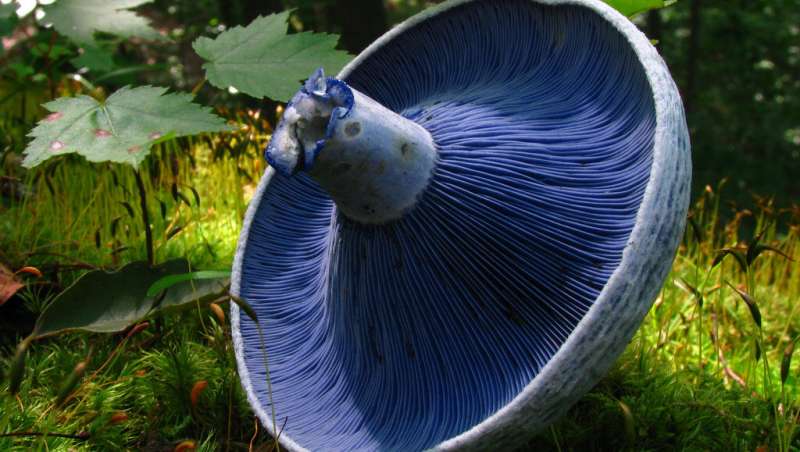Blue mushroom dye used to develop new fluorescent tool for cell biologists

A new fluorescent tool for detecting reactive oxygen species based on a chemical found in mushrooms has been developed by scientists at the University of Bath.
Reactive oxygen species (ROS), such as free radicals and peroxides, are produced in cells under oxidative stress. Whilst present in healthy cells in small amounts, excessive ROS in cells are damaging and can lead to cancer and neurodegenerative diseases such as Alzheimer's Disease.
The scientists at Bath, collaborating with researchers in South Korea, have developed a new probe that biologists studying these diseases can use to see changes in cells under the microscope, helping them to understand the fundamental biological processes involving ROS.
They've created a family of new molecules—dubbed AzuFluor—based on azulene, a bright blue chemical found in the mushroom Lactarius indigo. It fluoresces when it comes into contact with a ROS in a one-way reaction, detecting tiny amounts of these reactive oxygen species.
Whilst most fluorescent probes absorb a single photon, AzuFluor absorbs two photons, meaning that two lower energy photons can be used to produce the same level of fluorescence. Using shorter wavelengths of light in infrared range means that the light can penetrate tissues more deeply without harming the cells. This technology has been shown to work in rat tissue; the researchers hope that in the future it could be used as a probe in the human body.
Dr. Simon Lewis, Senior Lecturer in the Centre for Sustainable & Circular Technologies (CSCT) at the University of Bath, said: "AzuFluor is a much smaller molecule and simpler to make than other two-photon fluorophores. Its small size makes it easy to diffuse and transport into cells.
"We aim to make a family of these fluorophores that can be used in a range of cell imaging applications."
Professor Tony James, also from the CSCT at Bath, said: "This research has wide-ranging potential applications in cell biology and the pharmaceutical industry and is a great example of a fantastic international collaboration between chemists at Bath and Professor Hwan Myung Kim and his group at Ajou University in South Korea."
More information: Lloyd C. Murfin et al, Azulene-Derived Fluorescent Probe for Bioimaging: Detection of Reactive Oxygen and Nitrogen Species by Two-Photon Microscopy, Journal of the American Chemical Society (2019). DOI: 10.1021/jacs.9b09813
Journal information: Journal of the American Chemical Society
Provided by University of Bath




















